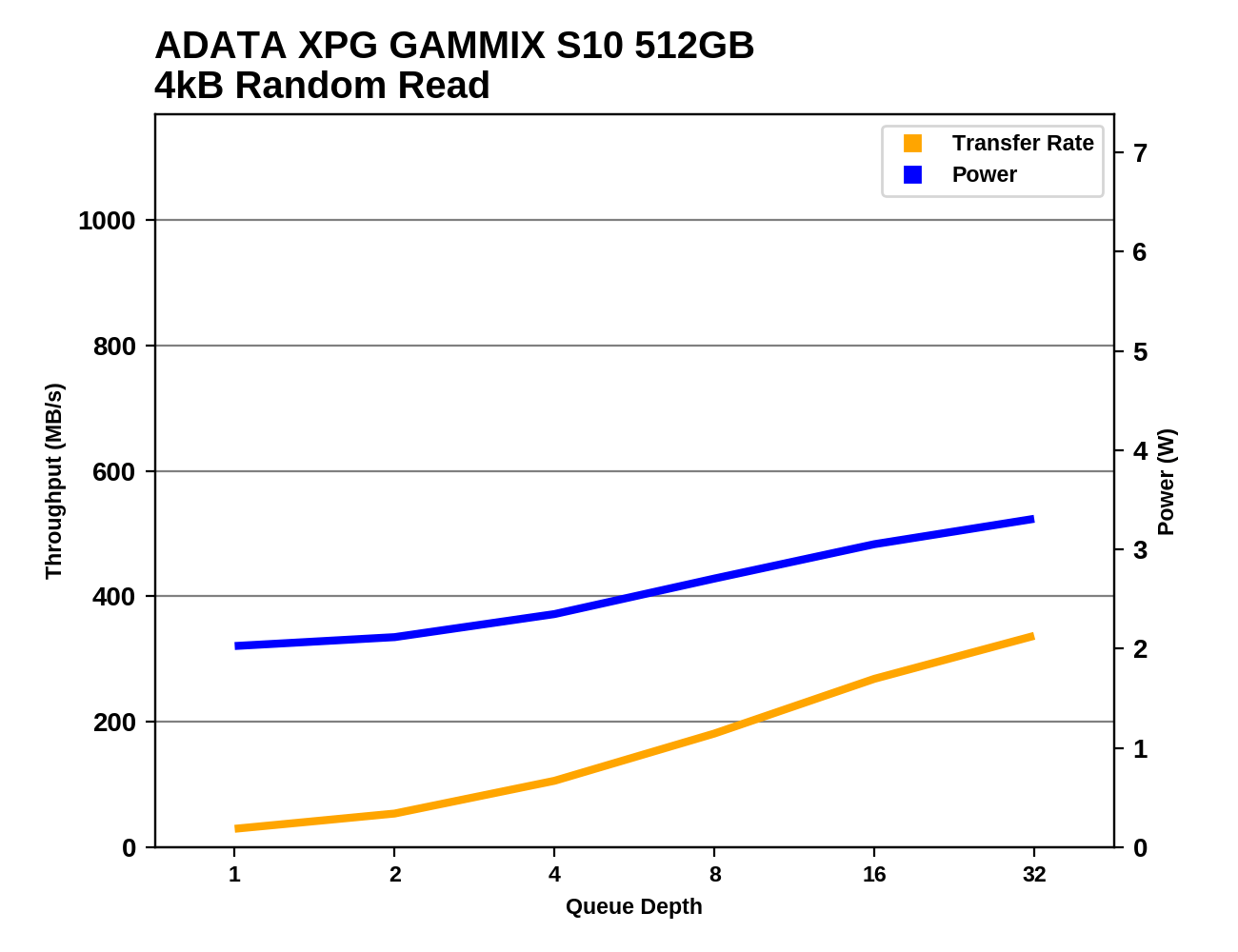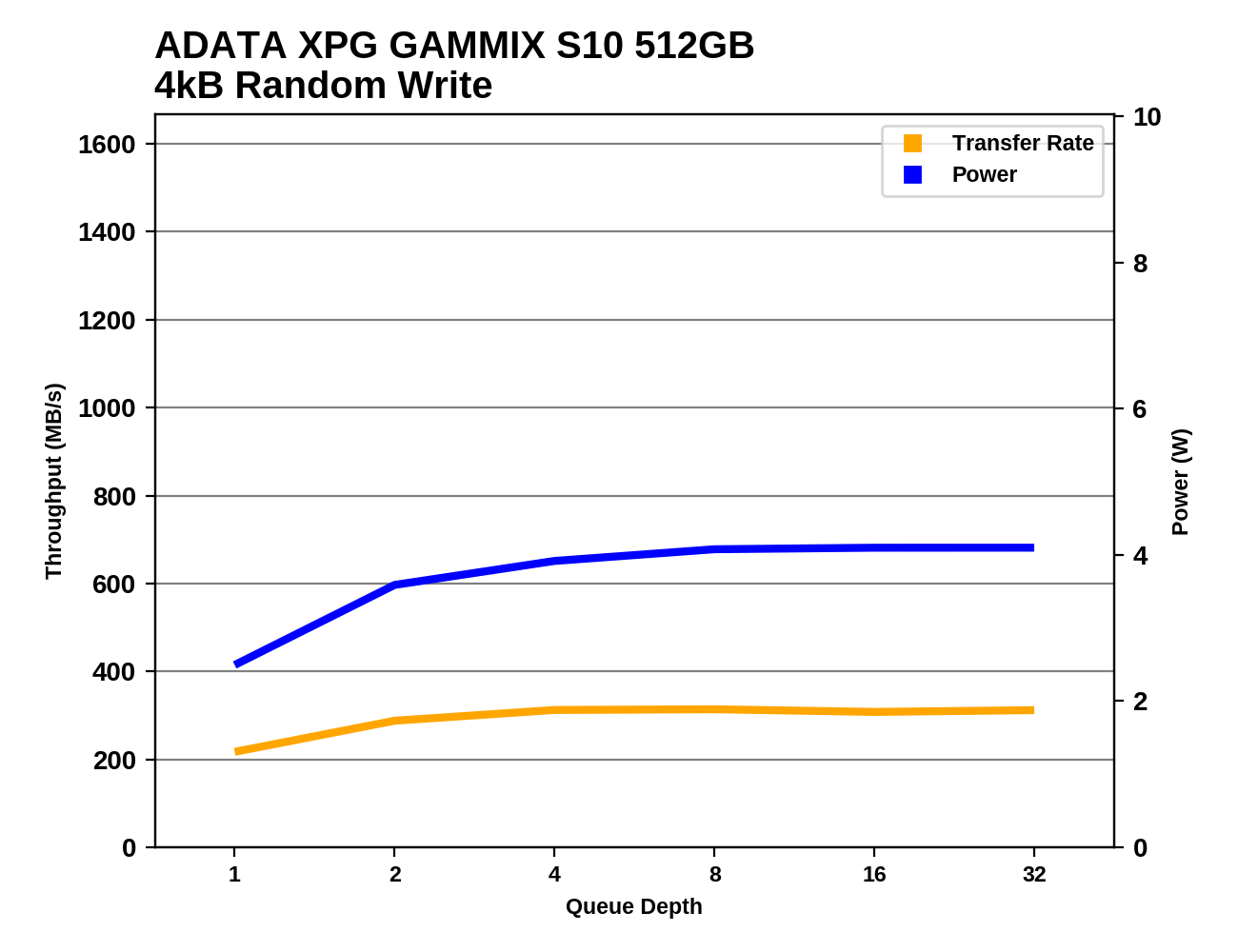The ADATA XPG GAMMIX S10 (512GB) SSD Review: Entry-Level NVMe With Style
by Billy Tallis on October 25, 2017 8:30 AM ESTRandom Read Performance
Our first test of random read performance uses very short bursts of operations issued one at a time with no queuing. The drives are given enough idle time between bursts to yield an overall duty cycle of 20%, so thermal throttling is impossible. Each burst consists of a total of 32MB of 4kB random reads, from a 16GB span of the disk. The total data read is 1GB.

The burst QD1 random read speed of the ADATA XPG GAMMIX S10 is much better than that of the Intel 600p, but still slower than Samsung's SATA SSDs and any other NVMe SSD. The GAMMIX S10 has the highest burst random read speed of any SSD we've tested with Intel/Micron 3D NAND, including the Intel 545s with the second-generation 64L 3D NAND.
Our sustained random read performance is similar to the random read test from our 2015 test suite: queue depths from 1 to 32 are tested, and the average performance and power efficiency across QD1, QD2 and QD4 are reported as the primary scores. Each queue depth is tested for one minute or 32GB of data transferred, whichever is shorter. After each queue depth is tested, the drive is given up to one minute to cool off so that the higher queue depths are unlikely to be affected by accumulated heat build-up. The individual read operations are again 4kB, and cover a 64GB span of the drive.

When higher queue depths and longer run times come into play, the random read speed of the GAMMIX S10 doesn't look so good. It is merely tied with the Crucial BX300 and behind the Intel 545s instead of being the fastest Intel/Micron 3D NAND SSD, and everybody else's flash offers faster random read speeds.

The GAMMIX S10 has poor power efficiency to go along with its poor random read speeds. The best NVMe SSDs using TLC NAND are close to twice as efficient for random reads as the GAMMIX S10.
 |
|||||||||
The Intel 600p and Crucial MX300 are the only SSDs in this bunch that are slower than the GAMMIX S10 at every queue depth. Any other NVMe SSD scales to much higher random read performance as queue depth increases.
Random Write Performance
Our test of random write burst performance is structured similarly to the random read burst test, but each burst is only 4MB and the total test length is 128MB. The 4kB random write operations are distributed over a 16GB span of the drive, and the operations are issued one at a time with no queuing.

The burst random write speed of the ADATA XPG GAMMIX S10 is pretty good for a TLC-based NVMe SSD. MLC-based NVMe SSDs with more powerful controllers can do even better, but the GAMMIX S10's performance is nothing to complain about.
As with the sustained random read test, our sustained 4kB random write test runs for up to one minute or 32GB per queue depth, covering a 64GB span of the drive and giving the drive up to 1 minute of idle time between queue depths to allow for write caches to be flushed and for the drive to cool down.

On the longer test of random write performance, the GAMMIX S10 is slightly faster than the Intel 600p and WD Black, which themselves hold a small advantage over SATA SSDs. Most other NVMe SSDs are quite a bit faster than the GAMMIX S10.

The power efficiency of the GAMMIX S10 during the random write test is not quite as bad as the Intel 600p or WD Black, but it is still poor with performance on par with early NVMe drives like the Samsung 950 PRO and notoriously power-hungry Intel 750.
 |
|||||||||
The random write speed of the ADATA XPG GAMMIX S10 has mostly saturated by QD2, and the top speed it reaches on this sustained performance test is lower than many mainstream SATA SSDs. Most NVMe SSDs of this capacity or larger are able to continue increasing performance as queue depths grow, leading to performance that surpasses the limits of SATA.










27 Comments
View All Comments
futrtrubl - Wednesday, October 25, 2017 - link
Disappointing.jabber - Wednesday, October 25, 2017 - link
Why? You wouldn't notice if it could do 3500MBps either.futrtrubl - Thursday, October 26, 2017 - link
Because it does less but costs more. What isn't disappointing about that?jabber - Thursday, October 26, 2017 - link
Yeah but it looks much fancier so to the average Joe that's worth another $30! It's a strategy that Apple has used and been praised for for decades. Performance means nothing to the computing masses. It's just those of us on IT forums that care.FullmetalTitan - Thursday, October 26, 2017 - link
No "average Joe" is even looking at NVMe SSDs.This costs double the price of a GOOD SATA SSD, and frequently fails to even meet that performance level.
jabber - Thursday, October 26, 2017 - link
You'd be amazed at what I see 'Average Joe's buy. Shocking at times."Why did you buy...that?"
ddriver - Wednesday, October 25, 2017 - link
That's some pristine engineering idiocy right there, having the heatsink make contact with only a small part of the chip area deliberately.ddriver - Wednesday, October 25, 2017 - link
"GAMMIX" - more like "gimmix" LOLrrinker - Wednesday, October 25, 2017 - link
I saw that skipped right to the conclusion for the (predicted) disappointing results. If they screw up the engineering for the sake of appearance like that, I was sure the rest of it would be disappointing as well.ddriver - Wednesday, October 25, 2017 - link
The thing is that the heatsink is protruding between the adhesive pads, so it presumably makes contact with the chip, however without any thermal interface material it is likely that the heatsink severs to insulate and worsen thermal performance than to improve it.Probably it is a mix of both, yielding somewhere between barely improving to barely "detrimenting" thermal performance, making it mostly a pointless gimmick.
Like everyone else, ADATA is well aware how low average consumer IQ is, thus attempting to make this fly.
On the bright side of things, adding some thermal paste would easily make the cooling solution functional. Although I doubt the product performance will get any less pathetic because of that. They didn't put that heatsink there because it is throttling as a side-effect of being very fast. They put it as a cosmetic feature, that much is evident from the clumsy implementation.